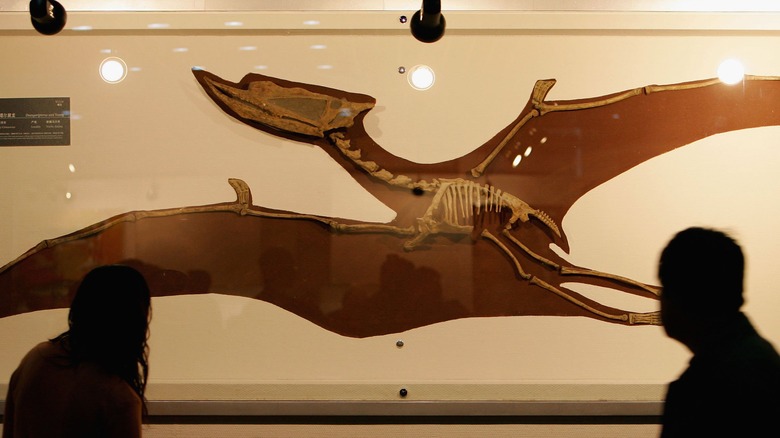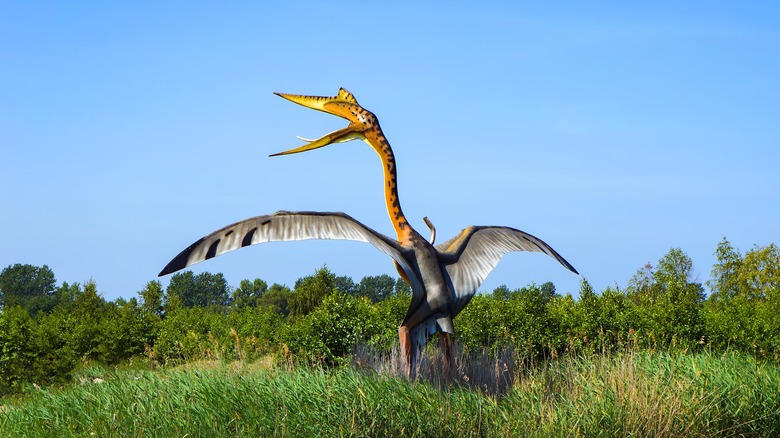Scientists Confirm A Controversial Physical Feature Of This Prehistoric Creature
A new study has found a lot of information about the evolution of feathers. We've all heard of the theory that the closest descendants of the Tyrannosaurus rex are modern-day birds, such as chickens and ostriches, but many of us still can't picture a feathered dinosaur. Pterosaurs were flying reptiles closely related to dinosaurs and were around for most of the Mesozoic era. Although some studies report that a decline in the pterosaur population — caused by having to compete with similar species — started long prior to the blow that took out most of the life on Earth, they were likely around in some capacity until the very end. Pterosaurs went extinct, alongside many other species, during the Cretaceous-Paleogene dinosaur extinction event, estimated to have taken place some 66 million years ago.
However, according to a recently examined pterosaur fossil, some pterosaurs not only had feathers, they had branched feathers like birds. What's perhaps more interesting is that feathers as a feature may be much older than initially believed. The fossil comes from a private collector, but it holds findings that Professor Maria McNamara of University College Cork in Ireland never expected. The partial skull of a Tupandactylus imperator, which is a type of pterosaur, seemingly proves that this type of dinosaur had feathers much like those of the birds we see out in nature in 2022. The feathers weren't just branched, but also possibly quite colorful.
Feathers may be 100 million years older than previously thought
Through careful examination and all kinds of testing, the team of scientists was able to reach some interesting conclusions based on the fossil. They published their findings in a study in Nature, including close-up photos of the branched feather in question, preserved in a limestone slab. "To me, these fossils seal the deal — pterosaurs really had feathers," Professor Steve Brussate of the University of Edinburgh — who performed a peer review of the study — told NBC News. The fossil is estimated to be around 113 million years old, which in itself is rather mind-boggling. According to the study, the fossil suggests that feathers may have first emerged as early as around 250 million years ago in animals similar to pterosaurs, given that birds, dinosaurs, and pterosaurs all share similar ancestors. This would indicate the emergence of feathers to have come 100 million years earlier than previously thought.
The researchers used a high-powered electron microscope to examine the feathers and the skin of the pterosaur. This led them to discover melanosomes. A melanosome is an intracellular organelle found in animal cells and is responsible for storing melanin, which in turn affects things such as the color of feathers in birds. Finding melanosomes in the pterosaur's feather confirms an early link to birds and suggests that the feathers were more colorful than initially thought.
Shorter feathers helped pterosaurs stay warm
Even more information can be gained from those pterosaur feathers. The study indicates they were fairly small, meaning that they weren't used to help the animal fly. Instead, the feathers could have played a role in regulating body temperature, serving as a sort of fluffy covering that helped the pterosaurs stay warm. This is corroborated by an earlier study co-authored by McNamara. As professor McNamara told NBC News, another potential purpose for the feathers could have been visual communication, such as attracting potential mates or scaring enemies; this would explain the multi-colored nature of the feathers. The scientists speculate that some of the simpler feathers were dark, but the branched variety was likely lighter in color. Ph.D. students working with McNamara are still working out the exact coloring of the pterosaur's crest based on these findings.
McNamara's earlier findings have not gone undisputed. Professor David Martill published a rebuttal to McNamara's paper in regards to the pterosaurs' allegedly fluffy covering. At the time, he found the evidence to be insufficient. However, as McNamara said to NBC News, the pterosaur fossil has all the same features of a feather, including the structure, melanosome presence, and chemical signatures for keraton. We may never know for certain, but this seems to be as close as it can get to a full confirmation of something that took place up to 250 million years ago.


